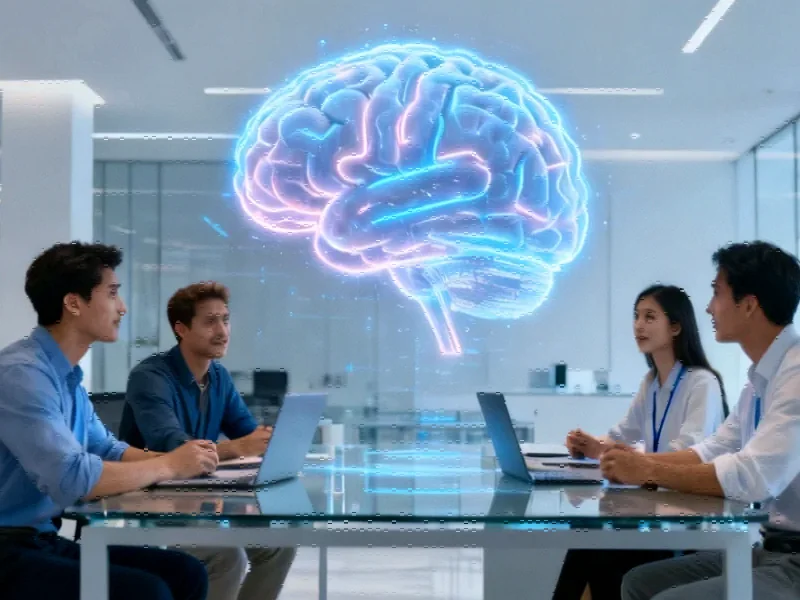The AI Spending Paradox
As the U.S. economy navigates the complexities of trade policies and global market shifts, a powerful counterforce has emerged: unprecedented corporate investment in artificial intelligence infrastructure. According to Torsten Sløk, chief economist at Apollo Global Management, the massive capital expenditure directed toward AI development has not only blunted the predicted negative impacts of recent tariffs but has created potential for economic reacceleration in coming quarters.
“While the trade war remains a mild drag on growth, its impact is being more than offset by the tailwinds from the AI boom and the industrial renaissance,” Sløk noted in a recent analysis. This assessment comes amid what many economists describe as the most significant technology investment cycle in decades, with companies racing to build out AI data centers and computational infrastructure.
The Growth Engine Behind the Numbers
Harvard University professor Jason Furman recently highlighted the staggering proportion of economic growth attributable to this tech spending surge. In an analysis of first-half 2025 data, Furman revealed that investment in information processing equipment and software—while representing just 4% of GDP—accounted for a remarkable 92% of GDP growth during that period.
This concentration raises important questions about the sustainability of current growth patterns. Without the AI spending boom, economic growth would likely be significantly lower, potentially falling below 1% according to some estimates, compared to the Atlanta Fed’s latest projection of 3.9% for the third quarter.
Industrial Renaissance and Broader Impacts
The AI investment wave extends beyond pure technology sectors, triggering what Sløk describes as an “industrial renaissance” with substantial spillover effects. “With nearly 200 factory completions since mid-2023 and a $590 billion pipeline led by $5 billion-plus megaprojects, advanced manufacturing is set to be a durable growth engine for the U.S. economy,” he wrote.
This manufacturing resurgence has generated positive impacts across industrial real estate, private credit markets, and nationwide employment. The trend reflects how industrial computing infrastructure has become foundational to modern economic activity, with ripple effects extending far beyond the technology sector itself.
The Security Dimension in Digital Transformation
As businesses increasingly rely on digital infrastructure for critical operations, the importance of secure communication platforms has intensified. The massive AI investment cycle has accelerated adoption of secure messaging alternatives that can protect sensitive corporate information amid heightened cybersecurity concerns.
This security focus extends to industrial applications, where reliable computing systems are essential for maintaining operational continuity. Recent strategic AI integration across various sectors demonstrates how artificial intelligence is being deployed to enhance both efficiency and security in critical operations.
Geopolitical Context and Strategic Alliances
The AI investment surge occurs against a backdrop of shifting global alliances and technological competition. Recent international security partnerships reflect how technological advancement has become intertwined with geopolitical strategy, particularly in areas like advanced computing and artificial intelligence.
Meanwhile, corporate strategies continue to evolve through strategic acquisitions that position companies to capitalize on emerging technologies and market trends. These moves often complement internal AI development efforts, creating diversified approaches to technological advancement.
Sustainability Concerns and Future Outlook
While the current AI spending boom has provided a significant boost to economic indicators, economists and analysts are increasingly questioning its longevity. Deutsche Bank recently cautioned that while technology companies are indeed propping up markets and the economy, investors need to consider what happens when this extraordinary spending cycle eventually moderates.
The concentration of growth in a single sector creates vulnerability, particularly if AI investment fails to generate the expected productivity gains or if market conditions shift. As businesses navigate these evolving market trends, the relationship between technological investment and broader economic health will continue to be a critical area of focus for policymakers and corporate leaders alike.
What remains clear is that the current economic landscape represents a complex interplay between technological transformation, industrial policy, and global market dynamics—with artificial intelligence spending serving as both a powerful growth driver and a potential source of economic vulnerability depending on how the situation evolves in coming quarters.
This article aggregates information from publicly available sources. All trademarks and copyrights belong to their respective owners.
Note: Featured image is for illustrative purposes only and does not represent any specific product, service, or entity mentioned in this article.



